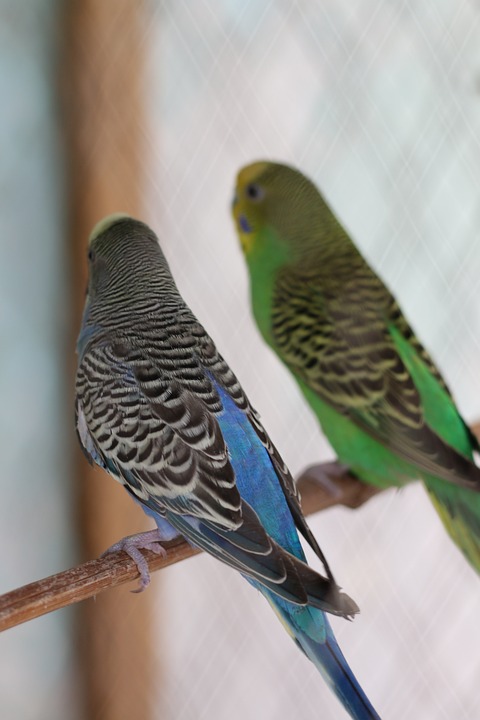**How to Recognize Signs of Overheating in Your Parrot and Offer Cooling Options**
Introduction
Keeping your parrot comfortable and safe in hot weather is essential for their well-being. Understanding the signs of overheating and knowing how to cool your parrot down can prevent serious health issues. This article aims to educate parrot owners on recognizing signs of overheating and providing effective cooling options.
Recognizing Signs of Overheating
Parrots, like humans, can experience heat stress. Here are some signs to look out for:
1. Increased panting and rapid breathing: Parrots regulate their body temperature by panting. If you notice your parrot breathing heavily, it may be a sign of overheating.
2. Wings held away from the body: Parrots will hold their wings away from their body to increase air circulation and cool down.
3. Fluffed-up feathers: Fluffing up their feathers is another way parrots try to cool themselves down. If your parrot appears fluffed up, it may be a sign of overheating.
4. Lethargy and decreased activity levels: Overheated parrots may become lethargic and show a decrease in their usual activity levels.
5. Open-mouthed breathing: When parrots are extremely hot, they may resort to open-mouthed breathing, similar to panting.
6. Drooping wings or tail: Drooping wings or tail can indicate heat stress in parrots.
7. Loss of appetite and decreased water consumption: Overheated parrots may lose their appetite and drink less water.
Taking Immediate Action
If you notice any of the above signs, it’s crucial to take immediate action to cool your parrot down. Here are some steps you can take:
1. Moving the parrot to a cooler location: Transfer your parrot to a cooler area of your home, away from direct sunlight and hot surfaces.
2. Providing fresh, cool water for drinking and bathing: Ensure your parrot has access to fresh, cool water for both drinking and bathing. Offer shallow dishes for them to dip their feet in.
3. Utilizing fans or air conditioning: Use fans or air conditioning to lower the ambient temperature in your parrot’s environment.
4. Offering frozen fruits or vegetables: Frozen fruits or vegetables can serve as a refreshing treat for your parrot and help cool them down.
5. Placing a damp towel or misting the parrot’s feathers: Damp towels or misting the parrot’s feathers can aid in evaporative cooling.
6. Avoiding direct exposure to sunlight or hot surfaces: Protect your parrot from direct sunlight and hot surfaces, as they can quickly lead to overheating.
Cooling Options
To prevent overheating in the long term, consider implementing these cooling options:
1. Setting up a misting system in the bird’s enclosure: A misting system can provide a consistent source of cooling for your parrot.
2. Creating a shaded area using UV protective materials: Create a shaded area within your parrot’s enclosure using materials that block harmful UV rays.
3. Installing a bird-safe water feature: A bird-safe water feature, such as a shallow pool or misting area, can provide a fun and cooling experience for your parrot.
4. Using a cooling pad or chilled ceramic tile: Place a cooling pad or chilled ceramic tile in your parrot’s enclosure for them to perch on and cool down.
5. Providing a shallow dish of water for foot-dipping: Parrots may enjoy dipping their feet in a shallow dish of water to cool off.
6. Hanging wet towels or frozen water bottles: Hanging wet towels or frozen water bottles near the bird’s cage can help lower the temperature.
Frequently Asked Questions about Parrot Overheating
1. Can all parrot species tolerate the same temperature range?
Different parrot species have varying temperature tolerances. It’s essential to research the specific needs of your parrot breed.
2. How does humidity affect a parrot’s ability to cool down?
High humidity can make it harder for parrots to cool down, as it hampers the evaporation of moisture from their bodies. Ensure adequate ventilation and consider using dehumidifiers if necessary.
3. Are there any specific parrot breeds or individuals more prone to overheating?
Parrots with smaller body sizes or thicker feathers may be more prone to overheating. Individual parrots with pre-existing health conditions may also be more susceptible.
4. Can I leave my parrot outside during hot weather?
It is not recommended to leave your parrot outside during hot weather. Parrots should have access to a controlled environment to ensure their safety and comfort.
5. What are the potential health issues associated with parrot overheating?
Parrot overheating can lead to heatstroke, dehydration, respiratory distress, and even death if not addressed promptly.
6. Can I use a regular fan to cool down my parrot’s enclosure?
Yes, a regular fan can help cool down your parrot’s enclosure. Just ensure it is placed at a safe distance and doesn’t create a draft directly on the bird.
7. Is it safe to use misting systems or water features in a parrot’s cage?
Misting systems and water features can be safe for parrots if designed with their safety in mind. Ensure that the water is clean, free from chemicals, and the enclosure is properly ventilated.
Conclusion
Being aware of the signs of overheating in your parrot and providing effective cooling options is essential for their well-being. By recognizing the signs and taking immediate action, you can prevent serious health issues. Implementing long-term cooling options can ensure your parrot stays comfortable throughout hot weather. Remember to seek veterinary advice if signs of heat stress persist, and continue educating yourself on parrot behavior and care to be the best parrot owner you can be.









